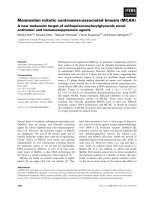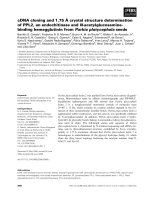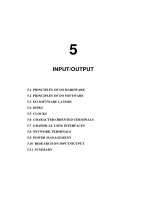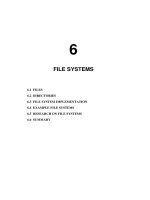A computer system consists of hardware, system programs, and application programs figs 2
Bạn đang xem bản rút gọn của tài liệu. Xem và tải ngay bản đầy đủ của tài liệu tại đây (463.93 KB, 45 trang )
2
PROCESSES AND THREADS
2.1 PROCESSES
2.2 THREADS
2.3 INTERPROCESS COMMUNICATION
2.4 CLASSICAL IPC PROBLEMS
2.5 SCHEDULING
2.6 RESEARCH ON PROCESSES AND THREADS
2.7 SUMMARY
A
B
C
D
D
C
B
A
Process
switch
One program counter
Four program counters
Process
Time
BCDA
(a) (b) (c)
Fig. 2-1. (a) Multiprogramming of four programs. (b) Conceptual
model of four independent, sequential processes. (c) Only one
program is active at once.
123
4
Blocked
Running
Ready
1. Process blocks for input
2. Scheduler picks another process
3. Scheduler picks this process
4. Input becomes available
Fig. 2-2. A process can be in running, blocked, or ready state.
Transitions between these states are as shown.
0 1 n – 2 n – 1
Scheduler
Processes
Fig. 2-3. The lowest layer of a process-structured operating system
handles interrupts and scheduling. Above that layer are sequential
processes.
Process management Memory management File management
Registers Pointer to text segment Root directory
Program counter Pointer to data segment Working directory
Program status word Pointer to stack segment File descriptors
Stack pointer User ID
Process state Group ID
Priority
Scheduling parameters
Process ID
Parent process
Process group
Signals
Time when process started
CPU time used
Children’s CPU time
Time of next alarm
Fig. 2-4. Some of the fields of a typical process table entry.
1. Hardware stacks program counter, etc.
2. Hardware loads new program counter from interrupt vector.
3. Assembly language procedure saves registers.
4. Assembly language procedure sets up new stack.
5. C interrupt service runs (typically reads and buffers input).
6. Scheduler decides which process is to run next.
7. C procedure returns to the assembly code.
8. Assembly language procedure starts up new current process.
Fig. 2-5. Skeleton of what the lowest level of the operating system
does when an interrupt occurs.
Thread Thread
Kernel
Kernel
Process 1 Process 1 Process 1 Process
User
space
Kernel
space
(a) (b)
Fig. 2-6. (a) Three processes each with one thread. (b) One process
with three threads.
Per process items Per thread items
Address space Program counter
Global variables Registers
Open files Stack
Child processes State
Pending alarms
Signals and signal handlers
Accounting information
Fig. 2-7. The first column lists some items shared by all threads in
a process. The second one lists some items private to each thread.
Kernel
Thread 3's stack
Process
Thread 3
Thread 1
Thread 2
Thread 1's
stack
Fig. 2-8. Each thread has its own stack.
Kernel
Keyboard
Disk
Four score and seven
years ago, our fathers
brought forth upon this
continent a new nation:
conceived in liberty,
and dedicated to the
proposition that all
men are created equal.
Now we are engaged
in a great civil war
testing whether that
nation, or any nation
so conceived and so
dedicated, can long
endure. We are met on
a great battlefield of
that war.
We have come to
dedicate a portion of
that field as a final
resting place for those
who here gave their
lives that this nation
might live. It is
altogether fitting and
proper that we should
do this.
But, in a larger sense,
we cannot dedicate, we
cannot consecrate we
cannot hallow this
ground. The brave
men, living and dead,
who struggled here
have consecrated it, far
above our poor power
to add or detract. The
world will little note,
nor long remember,
what we say here, but
it can never forget
what they did here.
It is for us the living,
rather, to be dedicated
here to the unfinished
work which they who
fought here have thus
far so nobly advanced.
It is rather for us to be
here dedicated to the
great task remaining
before us, that from
these honored dead we
take increased devotion
to that cause for which
they gave the last full
measure of devotion,
that we here highly
resolve that these dead
shall not have died in
vain that this nation,
under God, shall have
a new birth of freedom
and that government of
the people by the
people, for the people
Fig. 2-9. A word processor with three threads.
Dispatcher thread
Worker thread
Web page cache
Kernel
Network
connection
Web server process
User
space
Kernel
space
Fig. 2-10. A multithreaded Web server.
while (TRUE) { while (TRUE) {
get next request(&buf); wait for work(&buf)
handoff work(&buf); look for page in cache(&buf, &page);
} if (page not in cache(&page))
read page from disk(&buf, &page);
return page(&page);
}
(a) (b)
Fig. 2-11. A rough outline of the code for Fig. 2-10. (a) Dispatcher
thread. (b) Worker thread.
Model Characteristics
Threads Parallelism, blocking system calls
Single-threaded process No parallelism, blocking system calls
Finite-state machine Parallelism, nonblocking system calls, interrupts
Fig. 2-12. Three ways to construct a server.
Process
ProcessThread
Thread
Process
table
Process
table
Thread
table
Thread
table
Run-time
system
Kernel
space
User
space
Kernel
Kernel
Fig. 2-13. (a) A user-level threads package. (b) A threads package
managed by the kernel.
Multiple user threads
on a kernel thread
User
space
Kernel
space
Kernel thread
Kernel
Fig. 2-14. Multiplexing user-level threads onto kernel-level
threads.
Network
Incoming message
Pop-up thread
created to handle
incoming message
Existing thread
Process
(a) (b)
Fig. 2-15. Creation of a new thread when a message arrives.
(a) Before the message arrives. (b) After the message arrives.
Thread 1 Thread 2
Access (errno set)
Errno inspected
Open (errno overwritten)
Time
Fig. 2-16. Conflicts between threads over the use of a global vari-
able.
Thread 1's
code
Thread 2's
code
Thread 1's
stack
Thread 2's
stack
Thread 1's
globals
Thread 2's
globals
Fig. 2-17. Threads can have private global variables.
4
5
6
7
abc
prog.c
prog.n
Process A
out = 4
in = 7
Process B
Spooler
directory
Fig. 2-18. Two processes want to access shared memory at the
same time.
A enters critical region
A leaves critical region
B attempts to
enter critical
region
B enters
critical region
T
1
T
2
T
3
T
4
Process A
Process B
B blocked
B leaves
critical region
Time
Fig. 2-19. Mutual exclusion using critical regions.
while (TRUE) { while (TRUE) {
while (turn != 0) /
*
loop
*
/ ; while (turn != 1) /
*
loop
*
/;
critical region( ); critical region( );
turn = 1; turn = 0;
noncritical region( ); noncritical region( );
}}
(a) (b)
Fig. 2-20. A proposed solution to the critical region problem.
(a) Process 0. (b) Process 1. In both cases, be sure to note the
semicolons terminating the while statements.
#define FALSE 0
#define TRUE 1
#define N 2 /
*
number of processes
*
/
int turn; /
*
whose turn is it?
*
/
int interested[N]; /
*
all values initially 0 (FALSE)
*
/
void enter region(int process); /
*
process is 0 or 1
*
/
{
int other; /
*
number of the other process
*
/
other = 1 − process; /
*
the opposite of process
*
/
interested[process] = TRUE; /
*
show that you are interested
*
/
turn = process; /
*
set flag
*
/
while (turn == process && interested[other] == TRUE) /
*
null statement
*
/;
}
void leave region(int process) /
*
process: who is leaving
*
/
{
interested[process] = FALSE; /
*
indicate departure from critical region
*
/
}
Fig. 2-21. Peterson’s solution for achieving mutual exclusion.
enter region:
TSL REGISTER,LOCK | copy lock to register and set lock to 1
CMP REGISTER,#0 | was lock zero?
JNE enter region | if it was non zero, lock was set, so loop
RET | return to caller; critical region entered
leave region:
MOVE LOCK,#0 | store a 0 in lock
RET | return to caller
Fig. 2-22. Entering and leaving a critical region using the TSL
instruction.
#define N 100 /
*
number of slots in the buffer
*
/
int count = 0; /
*
number of items in the buffer
*
/
void producer(void)
{
int item;
while (TRUE) { /
*
repeat forever
*
/
item = produce item( ); /
*
generate next item
*
/
if (count == N) sleep( ); /
*
if buffer is full, go to sleep
*
/
insert item(item); /
*
put item in buffer
*
/
count = count + 1; /
*
increment count of items in buffer
*
/
if (count == 1) wakeup(consumer); /
*
was buffer empty?
*
/
}
}
void consumer(void)
{
int item;
while (TRUE) { /
*
repeat forever
*
/
if (count == 0) sleep( ); /
*
if buffer is empty, got to sleep
*
/
item = remove item( ); /
*
take item out of buffer
*
/
count = count − 1; /
*
decrement count of items in buffer
*
/
if (count == N − 1) wakeup(producer); /
*
was buffer full?
*
/
consume item(item); /
*
print item
*
/
}
}
Fig. 2-23. The producer-consumer problem with a fatal race condi-
tion.
#define N 100 /
*
number of slots in the buffer
*
/
typedef int semaphore; /
*
semaphores are a special kind of int
*
/
semaphore mutex = 1; /
*
controls access to critical region
*
/
semaphore empty = N; /
*
counts empty buffer slots
*
/
semaphore full = 0; /
*
counts full buffer slots
*
/
void producer(void)
{
int item;
while (TRUE) { /
*
TRUE is the constant 1
*
/
item = produce item( ); /
*
generate something to put in buffer
*
/
down(&empty); /
*
decrement empty count
*
/
down(&mutex); /
*
enter critical region
*
/
insert item(item); /
*
put new item in buffer
*
/
up(&mutex); /
*
leave critical region
*
/
up(&full); /
*
increment count of full slots
*
/
}
}
void consumer(void)
{
int item;
while (TRUE) { /
*
infinite loop
*
/
down(&full); /
*
decrement full count
*
/
down(&mutex); /
*
enter critical region
*
/
item = remove item( ); /
*
take item from buffer
*
/
up(&mutex); /
*
leave critical region
*
/
up(&empty); /
*
increment count of empty slots
*
/
consume item(item); /
*
do something with the item
*
/
}
}
Fig. 2-24. The producer-consumer problem using semaphores.









